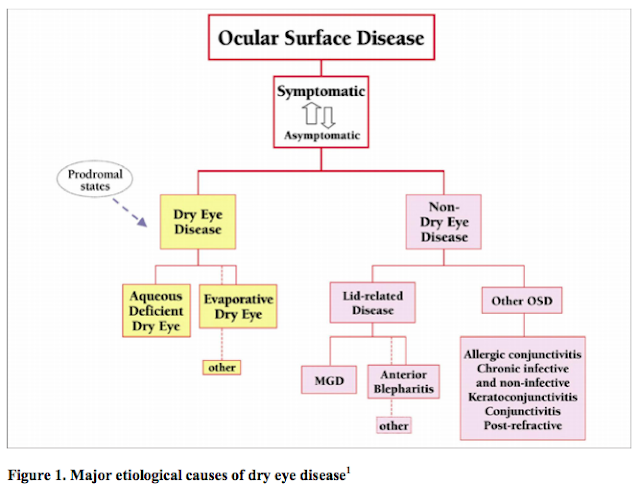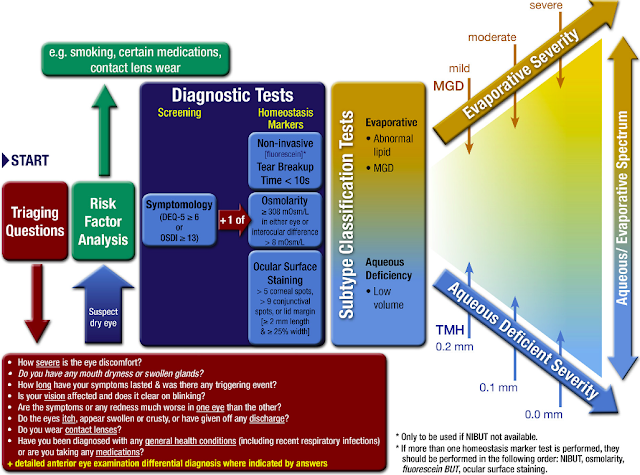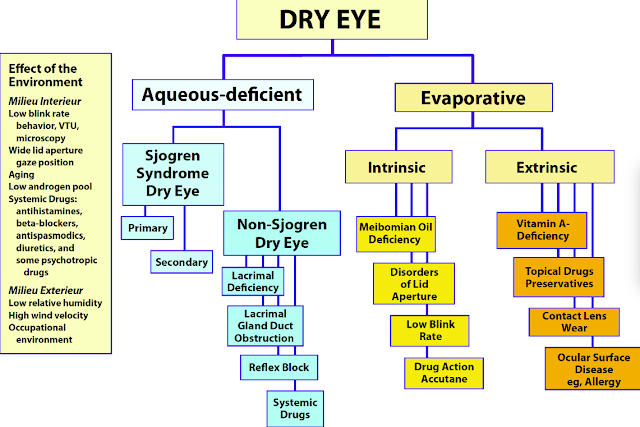Diagnosing dry eye has long been a subjective diagnosis. For years, it has been hard for eye surgeons and doctors alike to definitively diagnose “Dry Eye” objectively. This has frustrated many patients and doctors. More recently the concept of “Pain without Stain,” (or eye pain with little to no signs under the microscope) has forced researchers, eye surgeons, and doctors to expand our definition of dry eye disease. Additionally, the advent of meibography has, for the first time, helped us see the status of a key component of the tear film, namely the meibum oil.
This review on the definition of Dry Eye Disease hopes to clarify what dry eye disease is and what it is not.
In brief, dry eye disease is a complex, multifactorial disease that causes a myriad of symptoms including, pain (eye and even headaches), dryness, redness, tearing (reflex), blurry vision, stickiness, burning, foreign body sensation, irritation, eye noises, discharge. It is due to a disruption of the delicate cells that participate in the complex homeostasis (ie the “status quo”) of the ocular surface and surrounding structures.
Dry eye disease is NOT cancer, a tumor, a dangerous bacterial infection, a growing viral mass, herpes simplex, herpes zoster, but these things can make dry eye disease worse and even participate in its cause.
Thus this review below hopes to help millions of frustrated patients understand Dry Eye Disease better.
Just please blink often and look away and blink every few minutes.
SLC
In the past, Dry Eye was thought to be a separate entity, separate from allergic conjunctivitis. More recent data has pointed to the fact that inflammation is a root cause of eye discomfort, symptoms, and pain, and that dry eye is often present in many ocular surface disorder.
Old Paradigm:
Newer Paradigm
Many patients have come in with a variety of eye complaints ranging from “dryness,” “foreign body sensation,” “tearing” (which is often reflex tearing from an unstable tear film,” “redness,” “vision changes,” to “debilitating eye pain.”
Given the lack of objective findings in most cases, most eyeMDs and ODs told patients to do “lid hygiene” and take artificial tears and good luck.
There are many ways to classify Dry Eye Disease. Some of them are used for research purposes, some are used to see daily patients.
Review of DED Diagnosis:
One example of how to quantify DED: From Reference 2.
In 1995 National Eye Institute (NEI)/Industry Dry Eye Workshop: Dry eye is a disorder of the tear film due to tear deficiency or excessive evaporation, which causes damage to the interpalpebral ocular surface and is associated with symptoms of ocular discomfort.
The 2007 International Dry Eye Workshop, sponsored by the Tear Film and Ocular Surface Society [TFOS] provided an evidence-based critical review and summary of the classification, causes, epidemiology, diagnosis, techniques of basic and clinical research, and management of dry eye disease. It took 3 years and many experts to nail down a formal diagnosis.
Through time, eye researchers and surgeons saw this definition was not adequate to describe the severe pain often seen in the office without signs of clear dryness. Thus in 2017, the definition was broadened to include the possibility that the surrounding ocular nerves (ie, neurosensory) likely played a role that was not fully elucidated.
DEFINITIONS THROUGH TIME:
2005 1st NEI Definition
Dry eye is a disorder of the tear film due to tear deficiency or excessive evaporation, which causes damage to the interpalpebral ocular surface and is associated with symptoms of ocular discomfort.
2nd NEI Definition
Dry eye is a multifactorial disease of the tears and ocular surface that results in symptoms of discomfort, visual disturbance, and tear film instability with potential damage to the ocular surface. It is accompanied by increased osmolarity of the tear film and inflammation of the ocular surface.
2007 3rd International DEWS of the TFOS Definition
“Dry eye is a multifactorial disease of the tears and ocular surface that results in symptoms of discomfort, visual disturbance, and tear film instability with potential damage to the ocular surface. It is accompanied by increased osmolarity of the tear film and inflammation of the ocular surface.”
From Reference 1.
The definition of Dry Eye will continue to evolve as we further understand the role of the Trigeminal Nerve and the nerve pathway involving the release of aqueous from the Lacrimal Gland and meibum from the meibomian glands. Our ability to also define the positive antibodies related to underlying inflammation will also help us determine underlying causes and potentially best treatment options which can be different among patients.
By taking time to listen to our patients, which is very hard for eye surgeons in general, we can better help them understand why eye pain and eye symptoms are disrupting sleep and life, determine best treatment options, and give patients a more accurate prognosis for their lifetime.
SLC
References:
3. 2007 Report of the International Dry Eye Workshop (DEWS). The Ocular Surface. 2007;5:65-204. For a full copy of the DEWS report, please visit the TFOS website: www.tfos.org.
4. Behrens, A, Doyle, J, Stern, L, et al. Dysfunctional Tear Syndrome: A Delphi Approach to Treatment Recommendations. Cornea. 25:900-907, Sept. 2006.






